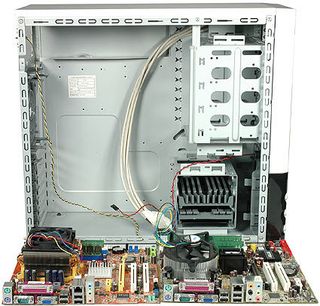The $300 PC
Which Is The Best Budget Computer?

This shootout is a bit different from what we usually do. It's not about the most sophisticated systems or about reaching new clock speed records. This article is for those who cannot or will not spend $300 for a processor, overclocked memory and an über graphics card. The reasons why people don't max out their credit cards or go hungry for a week to buy their dream machine vary, of course, but the good news is that $300 will buy you some decent PC gear these days.
There is a significant difference between cheap and expensive components, of course. High-end hard drives offer better performance and more storage capacity than cheap models. Expensive graphics cards provide great 3D acceleration and graphics processing. And expensive CPUs provide the processing power for demanding workloads and extensive multi-tasking. However, as long as you don't need any of that, a budget computer might still meet your needs.
As a matter of fact, many products in the budget segment share the same technology or manufacturing processes with mainstream and high-end parts. Production yields and customer demand often decide whether high-end, mainstream or low-end parts are produced. There are several variables to differentiate between high-end, mainstream and low-end products. It can be the number of components, such as multiple processing cores or multiple platters inside a hard drive; clock speed, bandwidth or other features that can easily be added or removed during the production process. Ultimately, an AMD Sempron processor utilizes a simplified Athlon 64 core. A 160 GB hard drive is likely based on the same design as its 500 GB sibling. Low-end graphics usually can process everything their bigger brothers can - but at reduced speeds.
Going the budget route doesn't mean as much as it used to. Even the slowest and cheapest processor available today is fast enough to operate Windows XP or Windows Vista and to run all sorts of office and multimedia applications. You do need more than 512 MB of RAM, but 1 GB of memory is reasonably affordable today. Almost every motherboard will do the job; the more expensive they get, the more features, interfaces, upgrade options and tuning capabilities they carry. Graphics is another opportunity to save money: If you don't play graphically-intensive games, you can always start with a motherboard that offers integrated graphics. Just be sure to get one that has an x16 PCI Express slot for future upgrades.
Our goal was to assemble a modern PC within a $300 budget (excluding the display and software), and we wanted to know whether an AMD- or an Intel-powered system offered the better deal. Obviously, our component decisions were largely based on cost, so we looked at the cheapest options first. We picked the products that offered the best value, even if it meant spending slightly more. To test the difference between what the AMD and Intel CPUs offered, we mostly used the same system components such as the case, power supply, RAM and DVD drive for both tests. We only used different motherboards and processors in our AMD and Intel budget-PC builds.
Join our discussion on this topic
Stay on the Cutting Edge
Join the experts who read Tom's Hardware for the inside track on enthusiast PC tech news — and have for over 25 years. We'll send breaking news and in-depth reviews of CPUs, GPUs, AI, maker hardware and more straight to your inbox.
Current page: Which Is The Best Budget Computer?
Next Page Component ConsiderationsMost Popular

